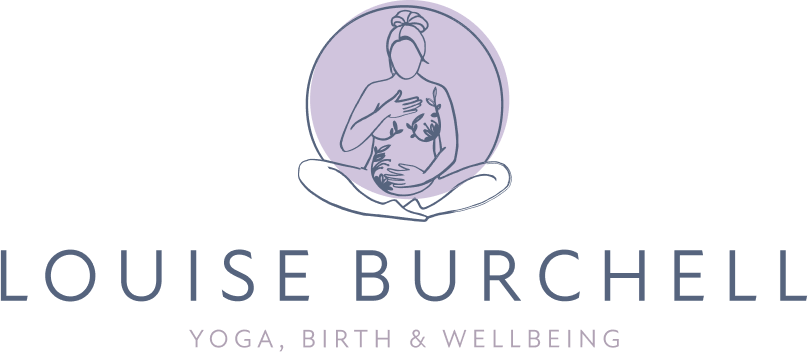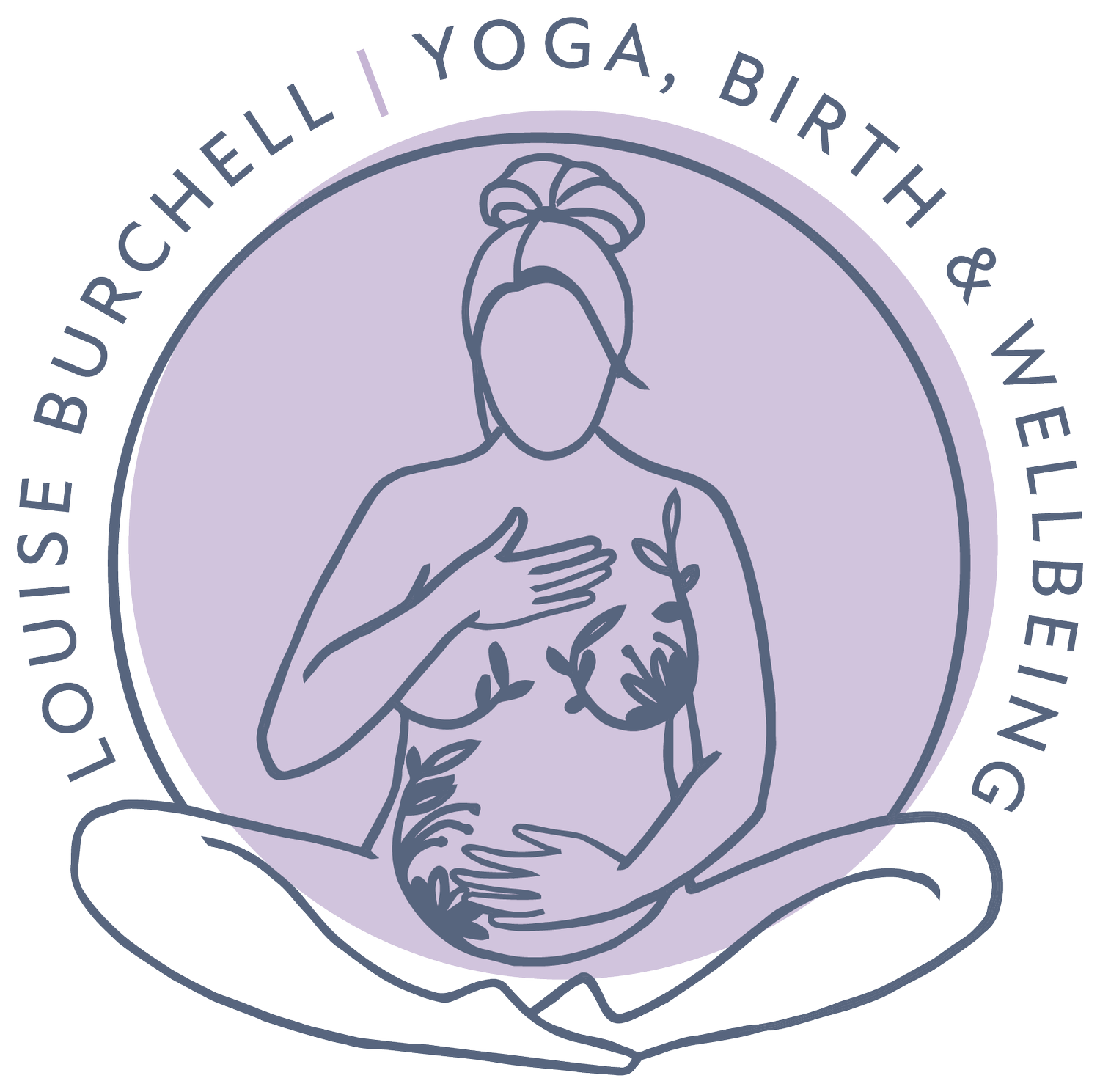What are the best breathing techniques for labour?
Download my Breathing Techniques for Labour PDF at the end
Breathing for birth is a key component of almost every antenatal, birth education or pregnancy yoga class. I know a lot of places teach various breathing techniques for birth, and I certainly used to teach three techniques in my pregnancy yoga classes, but do you know what? I didn’t use a single one of them during either of my two births.
Breathing techniques for an easier labour
I think sometimes we over-complicate breathing techniques so I want to keep it simple. I want you to learn how to tune into and control your breath so that you can use it during birth, or any time, in a way that works for you.
When we get caught up trying to count the length of each inhale and exhale, or visualise something specific (like a candle), this keeps the prefrontal cortex of your brain active - that’s the thinking part of your brain. The prefrontal cortex is the part of the brain that we want to switch off when we get deep into the birthing process so the birthing-goddess primal part of the brain can take over.
If I’ve said it once, I’ve said it a hundred times. Our body knows what to do, it’s our mind we need to convince. The best thing you can do during labour is give your brain the day off and let your body and baby do what they were designed to do.
I know that sounds like I’m only talking about vaginal births, but breathing techniques are essential for all births so if you have an abdominal birth (c-section) learning to use your breath is still essential. I’m also not suggesting that everyone can or should go through labour using only their breath - labour is hard (understatement of the year?), but no-one should suffer in fear and pain. There are many pain relief options, so make sure you educate yourself about the pros and cons of each.
Breathing techniques for labour pain relief
The only specific breathing technique I think it’s useful to practice is breathing IN through your mouth. Here’s why I want you to practice this possibly unorthodox way of breathing.
If you are going to use gas and air - AKA ‘Entonox’ - as pain relief, you must breathe in through a mouthpiece. You’ll hold it in your hand and suck in that air as if your life depends on it. But if you take shallow breaths, you won’t get enough Entonox into your bloodstream to create the pain relief you need. You have to be able to breathe in slowly and deeply through your mouth, which is the exact opposite of how most of us breathe our whole lives, so it’s something that is worth a little practice.
Does breathing really help labour?
It seems simple learning to breathe. We’ve done it every second since we were born. But it is surprisingly difficult. Do you ever feel like you just can’t quite take a full inhale, like your lungs just aren’t filling up enough, or your breath is caught in your upper chest?
When we are stressed, anxious or even just busy our breath becomes more shallow. Even your posture can affect the way you breathe. During pregnancy as your lung capacity is compromised by a growing baby, we tend to breathe in a much more shallow way, usually without even noticing.
Every breath you take oxygenates your own blood, and also sends oxygen to your baby. During labour, that’s especially important as you both need plenty of fresh oxygenated blood to energise you, maintain a healthy heart rate, keep your body working optimally and get you both through the challenging process of birth.
How do breathing techniques in labour work?
Your breath is a powerful tool that you have at your disposal all 👏 the 👏 time👏. When your sympathetic nervous system is activated by stressful events - for example like being in pain, feeling out of control, in an unfamiliar environment - you are in fight or flight mode. Your body and brain are primed to react to dangerous situations. Adrenaline and cortisol flood your body. And during labour, this is counterproductive.
Adrenaline is like kryptonite to Oxytocin and it’s Oxytocin - which you might know as the hormone of love but is also the hormone of birth - that we need in charge to allow labour to progress.
Breathing slowly and deeply, especially through your nose, activates your parasympathetic nervous system which signals the body to calm down, lowering cortisol, slowing your heart rate and bringing your body and mind back to a calm state.
You’re probably not going to feel calm every single moment of labour. Each contraction will challenge you. You might feel scared, even terrified, you might question whether you can cope, you’ll probably cry, or swear, or ask someone to help you or do it for you.
You can cope. The pain of a contraction will not last forever. If you can just breathe and hang on for a minute at a time, then you can do it. Take it one minute at a time. Don’t think about the next contraction or the ones you’ve already endured. Focus only on this one. You can give birth - and I mean birth of any kind, vaginal or abdominal, assisted or not. Use your breath to help you get through each difficult moment, and then use it even more during the moments of rest to bring your body as close as you can back to a state of calm.
Long, deep breaths can manage our stress response to anxiety, stress, fear, pain - all things that can crop up during birth - so yes, breathing techniques in labour do work.
That’s enough about the why’s of breathing, let’s move on to the how.
Yoga breathing techniques for labour
In my pregnancy yoga classes, this is how I teach breathing techniques for labour.
I get my class to sit or lie comfortably. And then I ask them to notice their breath. That’s it (to begin with at least). Just pay attention to their breathing.
Most of us go all day (all week, all month, all year?) without noticing how we’re breathing so the most important part of learning breathing techniques for labour is to simply start paying attention to your breath. Initially you’ll do this at a specific moment when you are “practising” but hopefully you’ll notice your breath more and more throughout your day as it becomes a habit.
There’s a PDF download at the bottom of this page with the full script I use to teach breathing techniques. Print it out, read it to yourself, get your birth partner to read it to you, or even record it so you can listen during labour.
Breathing techniques for active labour
If you are not using Entonox, then just keep focusing on breathing as slowly and smoothly through your nose as you can during active labour. That’s it. Keep it simple. Breathe through contractions and then use all your focus in-between contractions to use your breath to calm down, relax your body and oxygenate your body and your baby.
You might notice tension building up in your body as you have a contraction, so as soon as it fades try to let go of that tension by directing your breath there and breathing it away.
How do you use Gas & Air?
Entonox is available as pain relief both in hospital settings and for home births here in Scotland where I am, and the rest of the UK. If you are outside of the UK then check with your midwife or health practitioner.
As I mentioned, you breathe Entonox in through your mouth, so all that lovely calming nose breathing you’ve been practicing is suddenly not that helpful.
You’ll have a mouthpiece to hold firmly in your mouth and you need to create a tight seal around the mouthpiece with your lips. Equally important though is not clenching your jaw because this can cause you to tighten your pelvic floor muscles, which need to be as relaxed as possible to allow your baby through.
So there’s quite a lot to think about when using gas and air - mouth breathing, deep breaths, getting the timing right, hold tight but not too tight - which is why I think it’s useful to have practiced before birth.
You’ll probably only need to use Entonox for a minute or two at a time, taking a break from it between contractions so remember to breathe normally/slowly when you’re not using it.
TOP TIP: Entonox can make your mouth and lips really dry so have lip balm and a drink to hand.
Should you hold your breath during contractions?
No!!!! Your uterus is a magnificent muscular organ and like all organs it needs oxygenated blood to function optimally.
Plus, if you are using Entonox it will only flow from the tank when you breathe in, therefore the deeper and more effectively you breathe in, the better and more effective your pain relief. It usually starts working within about 20 seconds so it’s important that you start using it as soon as the contraction starts and that you breathe in smoothly and deeply to allow the pain relief to build with the contraction.
If you want to get really extra…
Now, to take this breathing practice an extra step you could cut the bottom off a plastic bottle and use the neck as your practice mouthpiece, which would give you some practice of creating a tight seal with your lips while keeping your jaw relaxed.
You probably will clench your jaw and grip on to the mouthpiece at some point, but as long as you are mindful of this and can remind yourself (or better yet your birth partner can remind you) to release that grip whenever you/they notice then that’s great.
Breathing Techniques for Labour and Birth PDF
Download my Breathing Techniques for Labour script to get you into the habit of noticing and controlling your breath and then when you are ready, add on the mouth breathing practice (with or without your pretend mouthpiece 🤓).
Once you are able to tune into your breath, you can use it any way that works for you. Slow it down. Add some movement: sway your hips, arch your back, rock back and forth in all fours or on your birth ball. Vocalise and make noises with each exhale.
Don’t be held back thinking you “should” be doing it a particular way. Let go, and let your Birthing Goddess take over.





